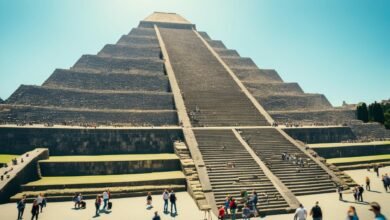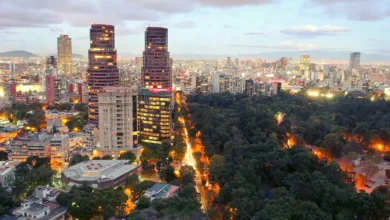Table of Contents
The Historic Center, or “Center” colloquially, is both the historic center and the beating heart of Mexico City. It’s vibrant, moving, and often packed with people, like Times Square but with more soul.
You can see the birth of the nation here, in the largest plaza in Latin America, with the Spanish colonial cathedral that was built over the Aztec Templo Mayor: the two great cultures whose influence has defined the city.
There’s a whirlwind of taquerias, murals, secret spots, and captivating architecture that gives Downtown such a distinct feel. To make the most of it, check out our guide on what to do in the Historic Center, also commonly known as Zócalo, the name of its main square.
Metropolitan Cathedral of the Assumption of the Blessed Virgin Mary into Heaven
This cathedral was built over two centuries (from 1573 to 1813) and is the largest in Latin America. The Spanish built it on the ruins of the Aztec Templo Mayor and used some of the stones from the fallen building to build the church. Since it was built for so long, it features a mix of Renaissance, Baroque, and Neoclassical styles in its design.
Secretary of Public Education
A ten-minute walk north of the Zócalo will take you in front of the Ministry of Education, a huge two-story government building that houses the offices of the Secretary of State for scientific and sports education. Why are you here? To see the beautifully preserved Diego Rivera murals that are arguably more impressive than those in the National Palace. Impressive in scope and scale, the murals depict the history of Mexico, from pre-Hispanic development and the arrival of the Spanish to the modern era.
Constitution Plaza
This incredibly large plaza, which marks the central node of Mexico City, is flanked by a massive flagpole with the Mexican flag. Before the Spanish invasion, El Zócalo was the main ceremonial site of the Aztecs. Today, it is considered one of the central stages for politics, cultural events and concerts.
Main temple
The Templo Mayor (translation: main temple) was the centerpiece of Tenochtitlán, the ancient Aztec capital, built in 1325 in the marshes of Lake Texcoco. The temple was torn down and replaced by a cathedral during the Spanish conquest in 1521. Today, the enormous stone ruins stand at the heart of the Historic Center, embedded in the city center plan. Surrounded by streets and buildings, it is difficult to imagine the temples in their original Aztec glory, but the well-organized museum helps paint the full picture.
Postal Palace
Designed by the same Italian architect, Adamo Boari, who did Beaux Arts across the street, the central post office is a wild mix of architectural styles: Spanish Rococo, Venetian, Neo-Gothic, Moorish, Neoclassical, Baroque, and Art Deco elements. present here. The space has been in operation as the city’s post office since 1907. Inside, the translucent variety of stone called “chiluca”, used throughout the interior and staircase, is particularly attractive.
Celaya Sweets
Open since 1874, this candy store is dedicated to traditional Mexican sweets. It feels a bit like a Parisian pastry shop, but the meringues, candied fruits, and coconut-flavored sweets transport you to Mexico City. The inventory is neatly organized on trays like precious jewels of every color, so even if you don’t have a sweet tooth to satisfy, it’s fun to explore.
Central mall
The oldest municipal park in Mexico has existed since 1529, when it served as an Aztec market. Today, the park serves as a gathering place for pedestrians in the otherwise concrete-filled Historic Center. You’ll find teenagers talking on the phone, elderly couples sunbathing, and parents chasing their kids on scooters. At one end of this well-kept rectangle is the Palace of Fine Arts; on the other, a series of cafes, mezcal bars, and shops. Take a peaceful walk near lavender fields, which fill the air with a pleasant aroma.
Jesus Nazarene Hospital
This is the oldest hospital on the continent and, legend has it, the place where Spanish conquistador Hernán Cortés and Aztec ruler Moctezuma first met in 1519. Although it is still a working hospital, it has a beautiful, lush courtyard and bright colors. mural that offers a relaxing hideaway in the middle of the Historic Center.
Latin American Tower
This 44-story skyscraper, built in 1965, is the tallest building in the Historic Center. The tower miraculously withstood both the 1985 magnitude 8.1 earthquake and the September 2017 magnitude 7.1 earthquake, making it a rare engineering feat.
The Tower defines the skyline of Mexico City (much like the Empire State Building in New York) and is a useful tool for finding your way around downtown. Head to the top-floor observation deck for stunning 360-degree views of the city, or the newly renovated bar/restaurant (one floor below), which has equally impressive views and is almost always empty.



